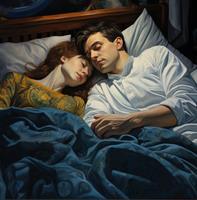Do you ever wonder why some people snore louder during certain stages of sleep? Understanding the link between snoring and sleep stages can provide valuable insights into how to improve sleep quality and overall health.
In this article we will delve into the fascinating world of sleep cycles, snoring patterns, and practical solutions to help you or your loved ones enjoy a better night’s sleep. Specifically, we will address the question, “what stage of sleep do you snore?”
Key Takeaways
-
Sleep stages have an impact on snoring, with light sleep and deep sleep associated with different causes and remedies.
-
Snoring solutions such as mouthpieces, lifestyle changes, environmental improvements or recognizing signs of sleep apnea can help improve overall quality of sleep.
-
Taking proactive steps to reduce the risk factors for snoring is essential in order to achieve better health outcomes.
Understanding the Sleep Cycle
Sleep consists of a complex series of stages, including non-REM (NREM) and REM (rapid eye movement) sleep, which cycle in ninety-minute intervals.
Each stage plays a crucial role in maintaining our overall health and well-being, with dreaming sleep being an essential part of the REM stage. Understanding the specifically normal sleep structure is vital for maintaining a healthy lifestyle.
Snoring patterns fluctuate with sleep stages. This article will delve into these stages and how they relate to snoring.
NREM Sleep Stages
NREM sleep stages encompass:
-
Light sleep (Stage 1): The brain produces very small, rapid waves, and the body commences its relaxation.
-
Commencement of sleep (Stage 2): Brain waves become larger and slower, and the body remains relaxed.
-
Deep sleep (Stages 3 and 4): Brain waves continue to be large and slow, and the body remains in a state of deep relaxation.
Deep sleep (Stages 3 and 4), also known as slow wave sleep, is particularly important for growth, repair, and memory retention. The brain produces very large and slow waves, and the body is in a state of profound relaxation. Tissue repair takes place, and growth hormones are secreted during this time.
A lack of REM sleep can detrimentally impact memory and learning, especially for those who are specifically REM sleep deprived.
REM Sleep Characteristics
REM sleep mirrors wakefulness in terms of brain activity and plays a vital role in memory and learning. Our bodies become immobile during this stage to prevent sleep-walking or acting out dreams. Maintaining a balanced sleep cycle is key to overall health, especially when it comes to falling asleep with ease and avoiding the need for REM sleep sleeping pills.
Insufficient REM sleep can lead to impaired functioning and potential health issues, such as sleep apnea. Obstructive sleep apnea, a condition that can disrupt REM sleep, can cause a range of health problems if left untreated. Therefore, it’s crucial to recognize the importance of REM sleep and its potential impact on snoring and overall health.
Snoring and Sleep Stages
Snoring predominantly occurs during deep NREM sleep stages, while sleep apnea is generally linked to REM sleep. Identifying the stage of sleep during which snoring occurs can help recognize potential sources and risk factors for snoring, as well as potential remedies and enhancements to sleep quality.
To comprehend the link between snoring and sleep stages, we will delve into snoring patterns during light sleep, deep sleep, and REM sleep, along with their possible causes and risk factors.
Light Sleep and Snoring
Snoring can occur during light sleep but is less common and intense than in deeper sleep stages. This can be attributed to the throat and airway muscles relaxing, partially obstructing the airway and causing vibrations.
To reduce snoring during light sleep, some recommendations include sleeping on one’s side, abstaining from alcohol and sleeping medications, and employing a humidifier. These measures can help alleviate snoring and improve overall sleep quality.
Deep Sleep and Snoring
Deep sleep stages (Stages 3 and 4) witness the highest prevalence of snoring due to muscle relaxation and slower breathing. This can lead to partial airway obstruction, resulting in the vibrations known as snoring.
Even individuals with sleep apnea can snore during deep sleep. Tackling the causes of snoring in this stage can enhance sleep quality and lower potential health risks.
REM Sleep and Snoring
Rem sleep snoring during REM sleep can be an indicator of sleep apnea, a potentially serious condition. Potential causes of snoring during REM sleep include:
-
Obesity
-
Alcohol consumption
-
Smoking
-
Certain medications
-
Anatomical issues such as a deviated septum or enlarged tonsils
Implementing lifestyle modifications, such as weight loss, abstaining from alcohol and smoking, and utilizing a snoring mouthpiece, may be beneficial for snoring during REM sleep. Optimizing the sleep environment can also aid in reducing snoring and improving overall sleep quality.
Causes and Risk Factors for Snoring
Snoring is not always attributed to a single cause. There are many possible contributing factors to snoring.
Snoring Factors
-
Allergies
-
Upper airway swelling
-
Dry air
-
Climate fluctuations
-
Dust
-
Pollution
-
Obesity
-
Anatomical features of the mouth and sinuses
-
Alcohol consumption
-
Diminished muscle tone due to aging
-
Inadequate muscle tone in the throat and tongue
-
Sleep position
-
Allergies
These factors, including how sleep pattern influences snoring, can contribute to snoring.
Understanding the underlying causes and risk factors for snoring paves the way for effective strategies and solutions to address these issues and enhance sleep quality.
Snoring Solutions and Sleep Quality
Various methods, including snoring mouthpieces, lifestyle changes, and improvements in the sleep environment, can enhance sleep quality and reduce snoring. These solutions do more than just alleviate snoring; they also contribute to overall health and well-being.
This article will delve into these snoring solutions in detail, discussing how they can enhance sleep quality and minimize potential health risks.
Snoring Mouthpieces
Snoring mouthpieces are devices worn in the mouth during sleep to minimize snoring. They work by maintaining the lower jaw in a slightly forward position, which aids in keeping the airway open and reducing snoring.
The advantages of utilizing snoring mouthpieces include diminished snoring, enhanced sleep quality, and enhanced breathing. However, some disadvantages include discomfort, difficulty articulating, and the necessity for regular cleaning and upkeep.
Lifestyle Changes
Lifestyle changes can also play a significant role in mitigating snoring. Weight loss can aid in reducing snoring by decreasing the amount of fatty tissue in the throat. Altering one’s sleeping position, such as sleeping on the side, can assist in reducing snoring by maintaining the airways open and diminishing the vibration of the soft palate.
Abstaining from smoking and alcohol consumption may be beneficial in diminishing snoring by decreasing inflammation in the throat and lessening the vibration of the soft palate.
Sleep Environment Improvements
Enhancing the sleep environment can also help reduce snoring. Addressing allergens in the sleep environment can be achieved by using dust mite covers on pillows and mattresses, washing bedding regularly in hot water, and using an air purifier.
Managing the humidity level of the sleeping environment can be done by employing a dehumidifier or a humidifier, depending on the existing humidity level. Regulating the temperature in the sleep environment can be achieved by utilizing a fan or air conditioner to maintain a comfortable temperature.
Recognizing Sleep Apnea
Identifying obstructive sleep apnoea is vital as it demands intervention and treatment to prevent possible health complications. Indications and manifestations of obstructive sleep apnoea specific symptoms include sleep apnoea signs such as sleep related respiratory difficulty.
Sleep Apnea Factors
-
Excessive daytime somnolence
-
Boisterous snoring
-
Witnessed episodes of arrested respiration during sleep
-
Awakening during the night and gasping or choking
-
Morning headaches
-
Dry mouth
-
Temperamental alterations
-
Disruptions in brain functioning
Untreated sleep apnea can result in serious health issues, including high blood pressure, stroke, heart attack, diabetes, depression, and other mental health disorders. Sleep apnea is typically diagnosed through a sleep study, and treatment options include lifestyle modifications, such as weight reduction and abstaining from alcohol, and the utilization of a CPAP machine. Surgery may also be a viable option.
Summary
In conclusion, understanding the relationship between snoring and sleep stages can provide valuable insights into improving sleep quality and overall health. By exploring sleep cycles, snoring patterns, and practical solutions such as snoring mouthpieces, lifestyle changes, and sleep environment improvements, we can help ourselves and our loved ones enjoy a better night’s sleep.
Remember, a good night’s sleep is essential for maintaining optimal health and well-being. Sweet dreams!
Frequently Asked Questions
Does snoring mean good sleep?
Snoring is not necessarily a sign of good sleep; using a CPAP machine, which keeps airways open during sleep and prevents snoring, leads to better quality sleep without snoring.
What does it mean if you snore at night?
Snoring at night is often a sign of weak throat or tongue muscles, or excess weight. It can be caused by aging, drinking alcohol, taking sleep aids, or certain medical conditions.
Does sleep cycle track snoring?
Yes, Sleep Cycle can track snoring as it picks up different sounds such as snoring and coughing during sleep. This can alert you to take action if needed.
What are the stages of the sleep cycle?
The sleep cycle is made up of NREM (non-REM) and REM (rapid eye movement) sleep stages, cycling through ninety-minute intervals throughout the night.
How do snoring mouthpieces work?
Snoring mouthpieces work by keeping the lower jaw slightly forward to aid in keeping the airway open, reducing snoring.
References
- The Relationship between Simple Snoring and Sleep Bruxism: A Polysomnographic Study. https://www.ncbi.nlm.nih.gov/pmc/articles/PMC7731201/







